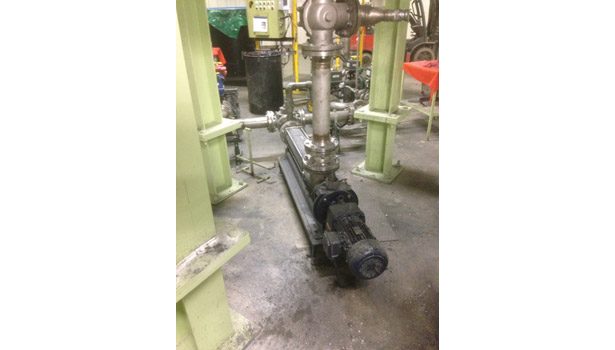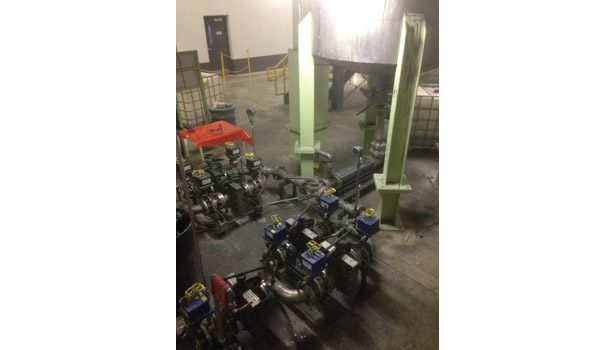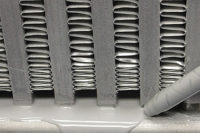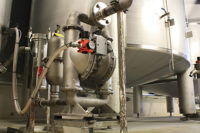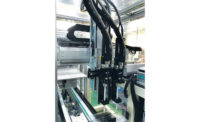As a member company of the AISIN Group, Aisin Chemical contributes to the automotive industry by developing and producing chemicals, friction materials and plastic parts. Aisin Chemical specializes in adhesives, coatings, and friction materials for transmissions and brake pads.
Aisin Chemical Indiana, LLC (ACIN), located in Crothersville, Ind., was established in 2006. The ACIN plant, which was constructed in 2011, produces an environmentally friendly, sound-dampening, spray-type adhesive known as a damping coat for companies such as Toyota, Nissan and Subaru. A damping coat improves the cabin environment. It is applied to the floors in automobiles to reduce vibration and road noise. Previous methods of manually attaching an asphalt sheet as a sound barrier have been replaced with automatic spraying of the damping coat directly to the floor of a vehicle.
This innovation enables coatings to be sprayed onto complex shapes, such as curved and vertical surfaces, with excellent adhesion that reduces vibrational noises much more effectively than other methods. The coating is comprised of a sticky adhesive base and fibers. Sound waves from bumps in the road, resonating metal in the engine or exhaust underneath the vehicle bounce upward, and the coating provides a barrier from the inside of the vehicle. Sound waves are trapped in the pockets between the adhesive and the fibers in the coating, breaking up the energy and thereby reducing unwanted vibration and noise.
Using the spray damping coat, however, meant that ACIN needed to find a new way to handle the viscous adhesive. A special kind of pump was required.
The Problem
When transferring the coating from production mixers to delivery drums, ACIN originally used two tri-lobe-style discharge pumps on an intermittent basis. These pumps suffered from excessive wear, caused a lot of downtime and lost efficiency, and were very expensive to repair. Essentially, the lobe pumps could not handle the abrasive fibers in the damping coat. When in use, the steel housing of the pump would begin eroding almost immediately because fibers became trapped between the rotating lobes and the casing. The surfaces of the lobes were often perforated and pitted.
ACIN’s standard for discharging the mixer was one hour and 15 minutes. When the discharge time exceeded two hours, the company would replace one lobe pump with the spare and then repair one pump while the backup performed the job and started wearing down again. This vicious cycle caused annual repair costs exceeding $30,000. In order to reduce repair and replacement costs, ACIN began looking for alternatives.
The Solution
seepex Inc., based in Enon, Ohio, manufactures progressive cavity pumps and offers reliable, cost-effective, and customized solutions for these kinds of applications. One of ACIN’s other damping coating suppliers had an excellent history with their seepex progressive cavity pumps for handling the coating and meeting discharge time goals. Hoping to have the same success, an ACIN facility-improvement team selected two seepex BN 26-12 progressive cavity (PC) pumps for the production line. The seepex PC pumps worked better because of their unique design, and the materials were chemically and erosion resistant.
In a progressive cavity pump, a single helix rotor turns insides a double helix stator to create cavities that progress from the suction to discharge to create flow. The compression fit between the rotor and stator is critical to the PC pump’s performance and longevity. The rotor coating and stator elastomer material were chosen out of dozens of types that seepex offers specifically for improved durability compared to the naked lobes and steel casings of a lobe pump. When the rotor slides over the stator, the elastomer of the stator will give and deflect the coating’s fibers instead of getting scratched and eroded like metal-to-metal steel lobes and housings.
Another beneficial component of the PC pumps is that they are equipped with a “TSE” run-dry protection device and controller that reliably protects the pumps from run-dry damage. This type of damage can occur when the stator is not properly lubricated, causing the rotor to burn the elastomer surface of the stator. If the flow of coating happened to stop for some reason, the pump would be safeguarded by the “TSE” device. A thermistor monitors the rotor temperature during every revolution of the rotor, and a temperature set-point is established so that if the rotor’s temperature goes above that setting, the controller automatically shuts down the pump.
“Yes, the device is installed on the pump, and we have yet to see its benefits—maybe because it is working!” says Tim Arnold, ACIN’s engineering and maintenance department manager and part of the company’s facility-improvement team. “We are glad to know it is there just in case to protect our investment.”
Proven Benefits
Since their installation in November 2010, the progressive cavity pumps have performed better than expected. The seepex pumps run about five hours a day and consistently meet mixer discharge time targets, now reduced by 15 minutes compared to the lobe pumps. Savings in operating costs have compensated for higher initial installation costs after just two years of use.
Arnold describes the benefits of the seepex pumps application as “a saving in excess of $60,000. There has been zero downtime to date.” •
For additional information, visit www.seepex.com.
